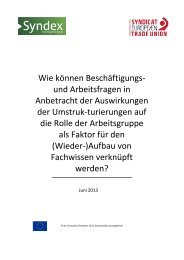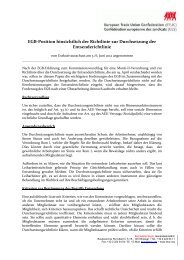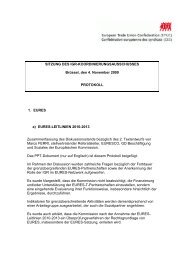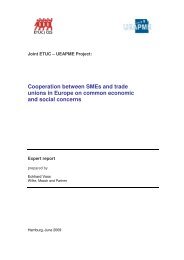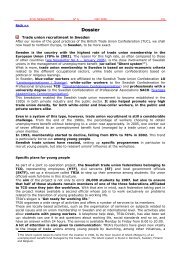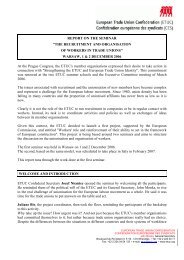Structural reforms and macro-economic policy - ETUC
Structural reforms and macro-economic policy - ETUC
Structural reforms and macro-economic policy - ETUC
Create successful ePaper yourself
Turn your PDF publications into a flip-book with our unique Google optimized e-Paper software.
precisely because they benefit from the flexible use of<br />
<strong>macro</strong><strong>economic</strong> instruments.<br />
But the structural propag<strong>and</strong>a is incorrect in other<br />
respects too. For one thing, notorious claims that<br />
positive confidence effects would come along with<br />
structural reform have been revealed as nothing but<br />
wishful thinking. If anything, Germany has proved<br />
the opposite to be true. As a result of the creation of<br />
job uncertainty, structural reform has undermined<br />
confidence. By implication, for structural reform to<br />
be successful there is a need for accompanying<br />
<strong>macro</strong><strong>economic</strong> policies that boost incomes <strong>and</strong><br />
dem<strong>and</strong> – rather than the opposite as is current<br />
practice.<br />
For another, suggesting that structural reform is<br />
also the answer to Spain’s competitiveness problem<br />
<strong>and</strong> external imbalance exposes seriously flawed<br />
thinking. No doubt structural <strong>reforms</strong> (intertwined<br />
with SGP-imposed public thrift campaigns) have<br />
played their part in weakening workers’ bargaining<br />
position in Germany, thereby nourishing Germany’s<br />
competitive wage disinflation. And of course,<br />
certain interest groups continue to push for still<br />
more of the same medicine for Germany. To restore<br />
its lost competitiveness, Spain would thus need to<br />
embark on even faster wage disinflation <strong>and</strong> even<br />
more ambitious structural reform. And yet Spain’s<br />
cumulative competitiveness loss is not the result of<br />
rigidities. Market forces have played out according<br />
to the script. Booming Spain has experienced higher<br />
wage-price inflation than stagnating Germany –<br />
just as the competitiveness channel would seem to<br />
require in its supposed role as dampener of cyclical<br />
divergences. To avoid the accompanying permanent<br />
<strong>and</strong> cumulative changes in competitiveness, market<br />
forces would at the same time need to bring about<br />
relatively lower wage-price inflation in booming<br />
Spain compared to stagnating Germany. Even if this<br />
were possible with unfettered market forces doing<br />
their natural work in an integrated currency union,<br />
which is hard enough to imagine, the competitiveness<br />
channel could then obviously not function as a<br />
dampener of cyclical divergences through net<br />
exports as a pull or drag factor on GDP growth as<br />
well. Proponents of the official flexibility doctrine<br />
appear to be keen to spoil whatever little credibility<br />
they may have left 6 .<br />
Competitive divergence is a serious<br />
threat to EMU<br />
The bottom line is that we are clearly asking too<br />
much of the competitiveness channel. In Mundell’s<br />
analysis, wage-price flexibility <strong>and</strong> nominal<br />
exchange rate adjustments are alternative expenditure-shifting<br />
instruments, applicable to restore<br />
external balance in the case of asymmetric shocks.<br />
In the case of common shocks, union-wide wageprice<br />
flexibility can be stabilizing when combined<br />
with a flexible common monetary <strong>policy</strong> – but only<br />
then. The official flexibility doctrine assumes<br />
wage-price flexibility to look after both external<br />
<strong>and</strong> internal balance as long as we abstain from<br />
proper use of <strong>macro</strong><strong>economic</strong> <strong>policy</strong> <strong>and</strong> no<br />
matter what kind of shock might derail the euro<br />
area. There is no theory to back up these confused<br />
beliefs. Persistent divergences <strong>and</strong> mounting<br />
imbalances are the consequence.<br />
In a recent interview upon retiring from the ECB<br />
Board, Otmar Issing once again confirmed how<br />
seriously muddled the euro area’s key <strong>policy</strong>makers<br />
are about developments in the economy<br />
under their stewardship. Issing (2006) expresses<br />
concerns about diverging unit-labour cost trends,<br />
which, he justifiably fears, may give rise to<br />
tensions. He suggests that by allowing their<br />
external competitiveness to deteriorate, certain<br />
EMU members have manoeuvred themselves into<br />
a difficult position which requires them to change<br />
course. The fact is that even in booming Spain,<br />
wage inflation has been very low by any st<strong>and</strong>ard.<br />
Another fact is that diverging unit-labour costs<br />
trends are due to Germany’s resorting to a beggarthy-neighbour<br />
strategy. Inviting others to follow<br />
Germany’s example <strong>and</strong> engage in competitive<br />
wage wars is a recipe for disaster (Bibow 2006b).<br />
And it should also be remembered here that one<br />
key motivation for EMU in Europe was to ban<br />
competitive devaluations forever. With the<br />
guardians of stability themselves now calling for<br />
that very kind of warfare between EMU partners,<br />
the euro may not be blessed with a long life.<br />
Mr Issing’s prescriptions provide yet another<br />
example of serious <strong>and</strong> systematic misdiagnosis,<br />
characterizing <strong>policy</strong>-making in the euro area.<br />
When the euro area was hit by a largely symmetric<br />
6 For instance, referring to persistent divergences in measures of competitiveness between member countries, Papademos (2005, p. 3) asserts that the<br />
‘persistence of these developments suggests that adjustment mechanisms are functioning slowly <strong>and</strong> that self-equilibrating forces are not sufficiently<br />
strong’. The notorious call for structural reform follows.<br />
PART 3: <strong>Structural</strong> <strong>reforms</strong> <strong>and</strong> the european <strong>macro</strong>-<strong>economic</strong> <strong>policy</strong> regime<br />
/ 85



